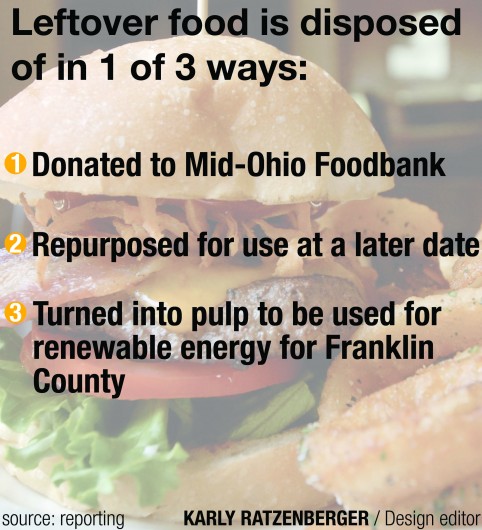Ohio State Dining Services has ways of repurposing leftover food on campus, but some employees feel more could be done to curb the waste.
Student Life spokesman Dave Isaacs said demand patterns most heavily dictate how much food is produced each day. Food in each dining facility is produced based on what Dining Services feels can be sold.
Not all of the food that is prepared each day is consumed, however.
There are three major ways that the surplus of food in the dining facilities on campus each day is salvaged, Isaacs said.
At the end of each day, uneaten food is donated to food banks, repurposed for use at a later date or pulped.
“We donate a significant amount to the Mid-Ohio Foodbank. We also repurpose the food that we can. If there are ways that are healthy and safe, we can reuse a product that perhaps was not needed on one day but can be used for something else,” Isaacs said.
Pulper machines on campus can also turn uneaten food into pulp by shredding leftover food and removing the liquid from it.
There are currently three pulpers in use on campus: one at Kennedy Commons and two at Ohio Union, with plans to install a fourth pulper in North Commons, Isaacs said.
After the liquid has been extracted from the waste, the pulp travels through pipes into vats that are emptied every 10 to 14 days. The pulp is then hauled to a facility where it is converted into a renewable energy source for Franklin County, Isaacs said.
OSU Dining Services, which has a yearly budget of $55 million for all OSU campuses, does not receive tax breaks for the food donations, and there is currently no information on how much the pulping process costs, Isaacs said in an email.
Even with the efforts in place to prevent food waste, some Dining Services employees said they feel more could be done to avoid tossing an excess of food at the end of the day.
One Dining Services employee, who wished to remain anonymous because of his employment, said more food could be donated when dining halls close each night.
“More food could definitely be saved. At the end of the day, (the dining halls) will throw away full bins of food like mac and cheese that could definitely be donated to a charity or soup kitchen,” said the male, first-year finance student, who works at Morrill Traditions.
He also said he doesn’t think demand patterns are always taken into account when food is being produced.
“The bread always gets thrown out at the end of the day because no one eats any of the rolls. There’s definitely stuff that no one ever eats but (it) continues to be made,” he said.
Other employees disagreed and said the amount of waste isn’t a problem.
“There isn’t really a lot of waste unless there’s a mess up where we made too much of something or made something wrong. When that happens, someone at work usually eats the food. If no one eats the food, it gets thrown away,” said Ben Wilson, an Oxley’s By the Numbers employee and a first-year in marketing.
OSU’s Undergraduate Student Government works with Dining Services to help diminish waste as well, said DaVonti Haynes, a second-year in public affairs and USG deputy director for on-campus issues of student affairs. In addition to the leftover food donated to the Mid-Ohio Foodbank each day, USG sponsors a program called Dare to Care, which lets students use remaining blocks in the last two weeks of each semester to buy non-perishable food from the three convenience stores or Pizza and Delivery, more commonly known as PAD, on campus. That food is then donated to the food bank at the end of the semester, Haynes said.
The Morrill Traditions employee said he still thinks more could be done to donate food, though.
“The dining halls do a decent job of saving food but I feel like they could do something else with a lot of the food that isn’t used. They could definitely donate more to a charity that needs (the) food,” he said. “I would even eat half the food the next day, but it gets thrown away. I understand them not serving some of the food the next day but a soup kitchen in the area would definitely use the food. And there’s a lot to give.”



